
The last view of our Falla before the ceremonial torching...
It was a most surreal experience right across the city. This yearly festival which, though only officially five days in actual duration, is in fact, a year-long labour of both love and money for many people. It ended abruptly in the very early hours of Thursday 20 March with the traditional burning of the Fallas across the city... a city which looked akin to the TV pictures of Beirut in my youth with burning pyres and thick black smoke rising across the skyline - accompanied by some of the most spectacular firework displays ever seen.
Wednesday evening, we headed for the city centre after dinner, to be accosted by young children throwing fireworks - a daily occurrence from 1 March onwards - arriving to view a number of the city's finest Fallas in their final hours of existence on this world...
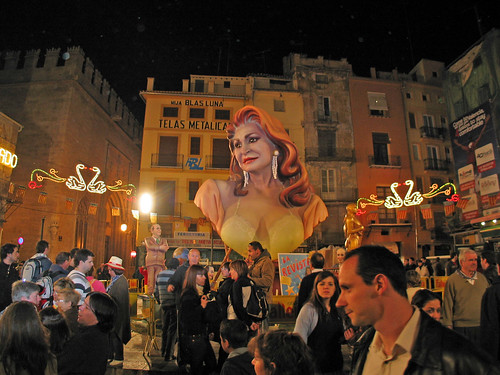
Fallas in the city - the final few hours...
After a couple of hours of wandering throughout the streets, seeing the great works of art - each one caringly designed and built over the preceding twelve months - we ambled back to a side street near the market to see the some of the many marching bands returning from their own musical trips around the neighbourhoods - to set fire to the children's ninot - something which, every year begins at 10.30pm on the evening of the 19th.
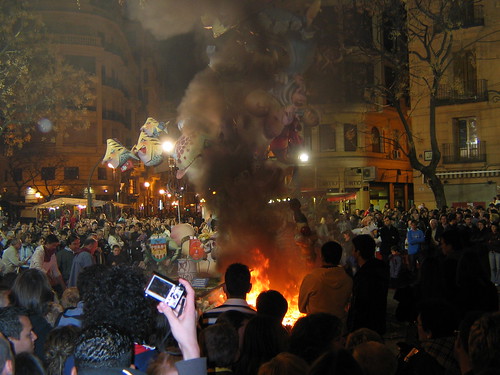
The first lick of the flames for the childrens' Falla
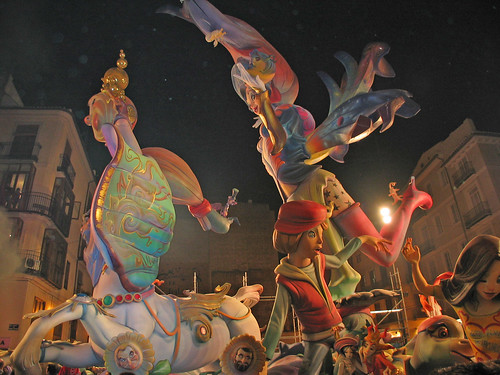
Another Falla...

...another fire!
Returning back to the apartment in Avenida de Francia for the midnight burning of our 'own' Falla, we discovered that since the fire brigade (bomberos in Castilian Spanish; bombers in Valenciano) have to be present at every burning, the allotted time for Avenida de Francia was not in fact midnight, but 1.30am the next morning, so we managed to keep some very tired children up for another hour-and-a-half until the bombers finally arrived to assist the local association in the cremation of the Falla.
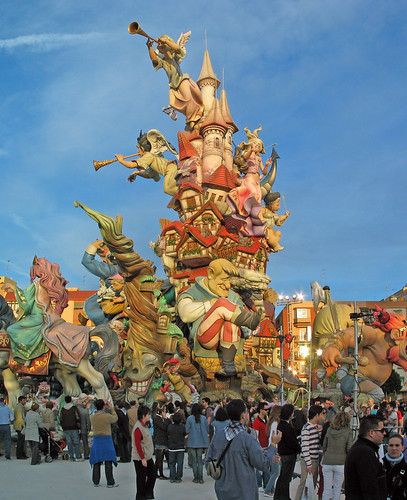
The biggest Falla this year - a €900,000 investment at Nou Campanar - and a great bonfire to boot!
None of the Brits present have ever experienced anything quite like the burning of a Falla. With hours of build-up, the final few minutes before 'lighting time' were conducted with a dousing of the structure in something highly flammable; fireworks kept going off all around us - many of them lit by myself and the children - totally legally, of course; the Falla Queens continued to meet and greet their followers; the bombers set up their firehoses; and the Valencian Anthem was playing steadily louder.

Outside our apartment, seconds after the Falla Queen lit the fuse... whoosh!
Finally, the TV cameras moved into position and the skies erupted with an amazing five-minute display of synchronised rockets before the Falla Queen was invited down to light the final 'fuse' - a string of exploding fire-crackers leading to the foot of the massive Falla. With an almighty bang and an instantaneous, searing whoosh of heat which left us and all the other spectators running backwards for shelter, the Falla exploded into a fireball of flames. As the fireball became an inferno, the bombers began hosing - not the fire - but the walls of our apartment (less than 3 metres from the edge of the flames) and the trees and shrubs surrounding the fire. This continued for much of the next thirty minutes or so until the final struts of the supporting frame of the Falla were reduced to a pile of burning embers and the bombers finally turned their hoses onto the fire itself, extinguishing the flames in a matter of a few minutes, turning the once-sweltering furnace into a giant pile of steaming charcoal and the Falla was no more.
As a footnote - the next morning, as promised - there was not a shred of evidence where the Falla had once stood, that anything had ever occurred. No scorch-marks. No burned embers. Just a simple road junction returned to its former state.
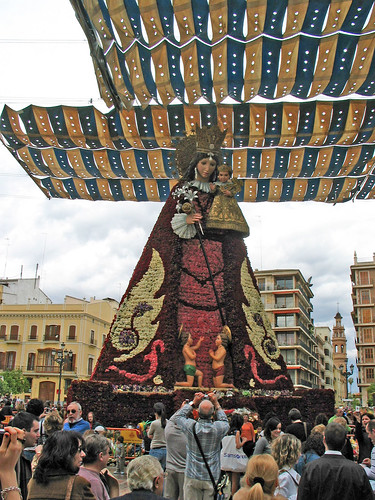
An amazing display of flowers at Plaza de la Virgen - creating a gigantic effigy of Our Lady every year as part of the Fallas celebrations. This year, the event coincided with Easter week
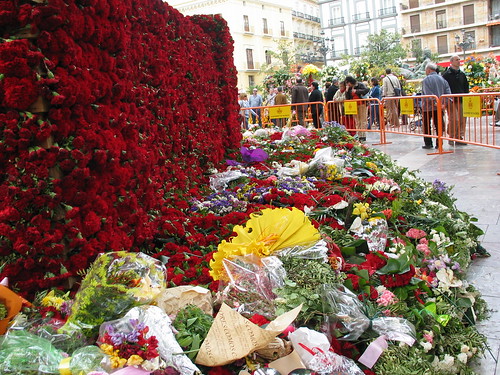
Yet more flowers at Plaza de la Virgen - their placement witnessed by tens of thousands of spectators - we could only get near nearly two days after the final flowers were laid
I now fully understand the explanations given of the Fallas festival in the tourist brochures. They talk about the history and tradition of Fallas and explain that Valencian people have learned to control fire. I have to admit, I was sceptical and thought this a bit of marketing bravado; however I now truly believe it really is the case. In many ways, 'our' Falla at Avenida de Francia was in one of the more 'open' locations - being plonked in the middle of a T-junction between a minor side street and the main avenue itself with only one apartment block on one side and pretty much open space on the other three sides. Many of the other 700 or so Fallas throughout the city and beyond, were packed into small crossroads and junctions with antiquated apartment buildings, shops and other ancient structures closely packed in on all sides. Every single one of those Fallas was burnt in the early hours of Thursday morning and I have yet to hear of any injury or 'mistake' which led to the accidental burning down of any of those buildings.
It does seem the strangest series of rituals - and for a 'tourist', quite a sad end to what must have been a protracted year-long programme of planning work, designing, building, fundraising, meetings and rehearsals. Perhaps for the people who create, celebrate and then burn these amazing structures, it is a simple repetition of a ritual passed down through the years in the same way as any other cultural practice. The Fallas year begins on 20 March each year - right after the last of the embers are cleared away from the previous Cremà.
I have video of many aspects of Fallas. I mean... I HAVE hours and hours of video! I will try to get some edited back to 10-minute slots as soon as I can in order to show off some of the highlights on this blog. In the meantime, Fallas has taught me quite a lot about what is and what is not a genuine community event - one which appears not to require a flood of public subsidy and government targets to ensure it provides value for the public purse, or the correct level of engagement and 'access' amongst its population. The event continues year after year - paid for by voluntary public subscription and private sponsorship. It truly involves everyone in some way or another - whether through participating in one of the 300 or more marching bands across the city, competing in the numerous Fallas Queen competitions, involvement in the Flower Offering at Plaza de la Virgen - even buying and throwing fireworks, eating and drinking the festive refreshments or participating in the many street events.
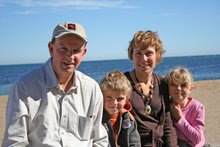
No comments:
Post a Comment